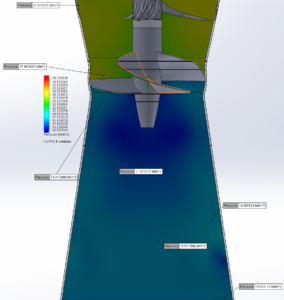By George Harvey
Two hydropower inventions currently going through the patent process could have far-reaching consequences. Both could enable smaller-scale hydro power projects by making them cost-effective where they had not been previously.
Closed-loop hydroelectric pumped storage
Pumped hydro has been proven a very successful way of storing large amounts of energy. When the spot price of power is low, typically in the middle of the night, electricity is used to pump water from a lower reservoir into a higher reservoir. At high-demand times, typically during the daytime and evening, the water in the high reservoir is allowed to run back into the lower reservoir, generating electricity as it flows, and this is sold at a higher price. Pumped storage enables electricity to be used when it is needed, instead of when it was originally generated. It acts as a big battery. An example of a pumped storage facility can be seen at http://bit.ly/Northfield-Mountain.
 Pumped hydro has a number of big advantages over other power storage systems. For example, where batteries hold toxic chemicals that could be spilled, pumped hydro has no such environmental risk. Closed-loop pumped storage cycles the water between an upper and lower “bathtub” and almost completely eliminates environmental damage.
Pumped hydro has a number of big advantages over other power storage systems. For example, where batteries hold toxic chemicals that could be spilled, pumped hydro has no such environmental risk. Closed-loop pumped storage cycles the water between an upper and lower “bathtub” and almost completely eliminates environmental damage.
One problem with these systems is that turbines can lose efficiency due to cavitations (bubbles) that rob efficiency. These have been eliminated by putting the turbines very low in systems, at the bottoms of deep tunnels conducting water between reservoirs. But the civil works involved, hollowing out mountains to build powerhouses, are very expensive, so usually only large systems will be cost-effective.
Henry Obermeyer, of Obermeyer Hydro in Ft. Collins, Colorado, realized that the high cost of the civil works could be avoided. Placed in a well, the turbine can take advantage of the water pressure to generate hydroelectric energy. From there, a pipe delivers the water to the lower reservoir. This system avoids the high cost of construction of an underground powerhouse, and allows small pumped-hydro sites to be cost-effective. This means that pumped hydropower can be installed in many places where it had not been practical in the past. Obermeyer’s design is cost-effective, for both large and small sites.
Obermeyer Hydro’s website is http://www.obermeyerhydro.com/.
A modular hydroelectric system for existing dams
The Kaplan turbine was invented a bit over a hundred years ago. It was a fairly sophisticated design with variable pitched blades and an adjustable wicket gate to operate effectively as conditions changed. But the turbines are mechanically complex and are more cost-effective at larger sites with output power greater than one megawatt.
Now, Lori Barg, founder of Community Hydro, in Plainfield, Vermont, has developed a modular system she is marketing under the name “GoHydro.” It is a semi-Kaplan turbine system that operates with high performance and efficiency with heads (vertical drops) between seven and fifty feet. This modular system is designed to arrive on the back of a truck and to be installed at an existing dam or drop. There is very little construction associated with the installation, which is designed for easy installation and can produce power within a month. The GoHydro system enables operation of smaller sites at lower cost.
Part of the magic of this newly invented design is that it makes it unnecessary to design and engineer each installation individually. Unlike most fixed speed hydro designs, this variable speed design maintains performance and efficiency at a range of head and flow. Turbines and other parts can be built to standard specifications in a factory, where they can be tested before going out for installation.
In the United States, there are almost eighty thousand existing dams that have no facility to generate power. These dams have been built and maintained for flood control, irrigation, municipal water supply, lakes and ponds and other reasons. They will not be removed, because they are needed. With the GoHydro system, many of these unpowered dams can produce electric power economically, adding to their value.
Adding modular hydroelectric power to some of these 80,000 existing dams will not have important negative environmental consequences. But the positive results are impressive. One study done for the Vermont Department of Public Service said that in Vermont alone, 90 megawatts of power could be added at existing dams.
Barg believes that the cost of this GoHydro system will be about $2,500 per kilowatt. This may sound high compared to solar power, which is close to $1,000 per kilowatt. But, the water flows pretty much full-time, producing about five times the amount of power that can come from a solar system with the same nameplate capacity.
The pilot site for GoHydro’s equipment is being installed in Peterborough, NH. GoHydro is looking for additional sites to install the GoHydro system.
For more information about GoHydro, visit http://www.communityhydro.biz/.









Leave a Reply